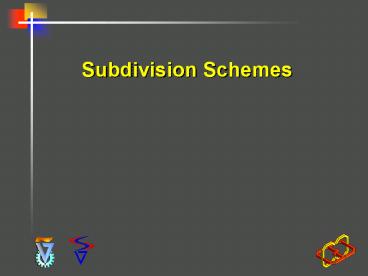Subdivision Schemes - PowerPoint PPT Presentation
Title:
Subdivision Schemes
Description:
Given a Subdivision scheme, does it converge for all polygons? ... Surface subdivision. A surface subdivision scheme starts with a control net (i.e. vertices, ... – PowerPoint PPT presentation
Number of Views:303
Avg rating:3.0/5.0
Title: Subdivision Schemes
1
Subdivision Schemes
2
What is Subdivision?
- Subdivision is a process in which a
poly-line/mesh is recursively refined in order to
achieve a smooth curve/surface. - Two main groups of schemes
- Approximating - original vertices are moved
- Interpolating original vertices are unaffected
Is the scheme used here interpolating or
approximating?
3
Why Subdivision?
Frame from Geris Game by Pixar
4
Why Subdivision?
- LOD
- Compression
- Smoothing
13.3Mb
424Kb
1Kb
52Kb
5
Corner Cutting
6
Corner Cutting
3 1
1 3
7
Corner Cutting
8
Corner Cutting
9
Corner Cutting
10
Corner Cutting Limit Curve
11
Corner Cutting
The limit curve Quadratic B-Spline Curve
A control point
The control polygon
12
4-Point Scheme
13
4-Point Scheme
14
4-Point Scheme
1 1
1 1
15
4-Point Scheme
1 8
16
4-Point Scheme
17
4-Point Scheme
18
4-Point Scheme
19
4-Point Scheme
20
4-Point Scheme
21
4-Point Scheme
A control point
The limit curve
The control polygon
22
Comparison
- Non interpolatory subdivision schemes
- Corner Cutting
- Interpolatory subdivision schemes
- The 4-point scheme
23
Theoretical Questions
- Given a Subdivision scheme, does it converge for
all polygons? - If so, does it converge to a smooth curve?
- Better?
- Does the limit surface have any singular points?
- How do we compute the derivative of the limit
surface?
24
Surface subdivision
- A surface subdivision scheme starts with a
control net (i.e. vertices, edges and faces) - In each iteration, the scheme constructs a
refined net, increasing the number of vertices by
some factor. - The limit of the control vertices should be a
limit surface. - a scheme always consists of 2 main parts
- A method to generate the topology of the new net.
- Rules to determine the geometry of the vertices
in the new net.
25
General Notations
- There are 3 types of new control points
- Vertex points - vertices that are created in
place of an old vertex. - Edge points - vertices that are created on an old
edge. - Face points vertices that are created inside an
old face. - Every scheme has rules on how (if) to create any
of the above. - If a scheme does not change old vertices (for
example - interpolating), then it is viewed
simply as if
26
Loops Subdivision - topology
- Based on a triangular mesh
- Loops scheme does not create face points
New face
Old face
Vertex points
Edge points
27
Loops subdivision stencil
- Every new vertex is a weighted average of old
ones. - The list of weights is called a Stencil
- Is this scheme approximating or interpolating?
The rule for vertex points
The rule for edge points
1
1
1
1
1
n vertex points valence
28
Loop - Results
29
Loop - Results
30
Loop - Results
31
Loop - Results
32
Loop - Results
- Behavior of the subdivision along edges
Loops scheme results in a limit surface which is
of continuity everywhere except for a
finite number of singular points, in which it is
.
33
Butterfly Scheme
- Butterfly is an interpolatory scheme.
- Topology is the same as in Loops scheme.
- Vertex points use the location of the old vertex.
- Edge points use the following stencil
34
Butterfly - results
35
Butterfly - results
36
Butterfly - results
37
Butterfly - results
38
Butterfly - results
The Butterfly Scheme results in a surface which
is but is not differentiable twice anywhere.
39
Catmull-Clark
- The mesh is the control net of a tensor product
B-Spline surface. - The refined mesh is also a control net, and the
scheme was devised so that both nets create the
same B-Spline surface. - Uses face points, edge points and vertex points.
- The construction is incremental
- First the face points are calculated,
- Then using the face points, the edge points are
computed. - Finally using both face and edge points, we
calculate the vertex points.
40
Catmull-Clark
Step 1
Step 2
Step 3
First, all the face points are calculated
Then the edge points are calculated using the
values of the face points and the original
vertices
Last, the vertex points are calculated using the
values of the face and edge points and the
original vertex
2
1
1
2
2
1
1
1
2
2
n - the vertex valence
Face points Edge points Vertex points
41
Connecting The Dots
- After Computing the new points, new edges are
formed by - connecting each new face point to the new edge
points of the edges defining the old face. - Connecting each new vertex point to the new edge
points of all old edges incident on the old
vertex point.
Gone
42
Catmull-Clark - results
43
Catmull-Clark - results
44
Catmull-Clark - results
45
Catmull-Clark - results
46
Catmull-Clark - results
Catmull-Clark Scheme results in a surface which
is almost everywhere
47
Comparison
Butterfly
Loop
Catmull-Clark
48
Pros and Cons
- Pros
- A single mesh defines the whole model
- Simple local rules
- Easy to implement.
- Numerical Stability
- Easy to generate sharp feature with
- Lod, Compression etc
- Cons
- Evaluating a single point on the surface is hard
- Not suitable for CAGD
- Mesh topology has great influence on the over all
shape. - May become expensive in term of rendering
- Global subdivision































